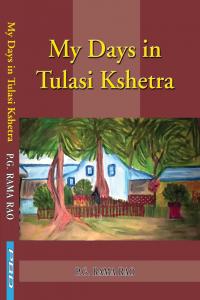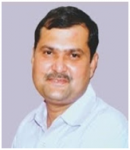Creation and Criticism
ISSN: 2455-9687
(A Quarterly International Peer-reviewed Refereed e-Journal
Devoted to English Language and Literature)
Vol. 01, Issue 03 : Oct 2016

My Days in Tulasi Kshetra by P G Rama Rao
P G Rama Rao. My Days in Tulasi Kshetra. Bareilly: Prakash Book Depot. First Edition: 2009. Second Edition: 2016. Pp. 165. Price: Rs. 220/- (Paperback). ISBN: 978-8179775592.
Reviewed by Abnish Singh Chauhan
P G Rama Rao’s conversation with his beloved students prompted him to pen down his chastening experiences and colourful reflections of mind and soul in My Days in Tulasi Kshetra, the memoirs of about his eighty years’ journey on different places of southern India. The memoirs activated his mind to contemplate and record seven geographical and chronological phases of his life: Tuni in Andhra Pradesh, where he was born and brought up and spent his schooldays (1935-49); Kakinada (A.P.), where he completed his college education (1949-53); Narsaraopet (A.P.), where he had his first teaching job in S S N College (1953-57); Kakinada (A.P.), where he had his second teaching assignment in P R Govt. College (1957-1962); Kendrapara (Orissa), where he had his third teaching work (1962-1983); Bhubneshwar (Orissa), where he had his fourth teaching task in Utkal University (1983-1995); Hyderabad (A.P.), where he has been living happily after retirement with his children and grand children since 1995.
Though Prof Rao, who has always considered Kaal as the real doer of action and individuals as only instrumental and, therefore, believed in the designs of the Supreme Being– the one who is all-pervasive, efficiently recollected and modestly imbibed a lot of things– Jnana during the ‘seven stages’ of his real life, it was his longest stay in Kendrapara which changed his state of mind and perceptions of the world. Kendrapara is also known as Tulasi Kshetra– a holy place of great importance in Hindu scriptures, where he, developing his interest in dream-interpretation and psycho-analysis, did his personal and professional obligations along with spiritual sadhana, and on getting divine inspiration realized, to large extent, how to do Karmas, how to know Maya, how to get Mukti or freedom from pain or suffering through constant prayers and how to love and worship Him. Consequently, the book begins with Kendrapara– ‘Why I Went to Kendrapara’, telling about his migration to this place for improving his academic qualifications and, to some extent, level of family life at the initial stage. The first story is magnificently clubbed with the other ones narrating the major happenings of a teacher’s life in socio-cultural and spiritual environment together with his points of view about those things in logical order. The suggestive titles and communicative texts of the next thirty six stories, especially ‘My Evening Walks’, ‘I Meet My Master’, ‘How Tulasi Kshetra Made My Mother’s “One-Lakh-Wick-Puja” Possible’, ‘Strange Dreams, Elevating Thoughts, and Chastening Experiences’, ‘Golok Behari Das’, ‘The Power of Prayer’, ‘The Death of My Father’, ‘Mantra or Sound Charged with Mind Power’, ‘The Power of Desire and Western Connection’, ‘I Go West’, ‘Back in Tulasi Kshetra: Business as Usual’, ‘The Devine Design’, ‘Prayer, Devotion and Faith’ and ‘Right, Wrong, and Prayer: My Understanding of Raas Babu’s Teachings’, effectively present, making the bridge between the first and the last stories and also connecting the other ones, striking memories with motivational messages of a middle-class man. The last tale of the book– ‘Death of a Saint’ conveys the ultimate truth of human life endowed with Advaita philosophy, as the author himself remarks: “For a person of higher spiritual sensitivity death and birth, grief and joy are the same and, therefore, he needs not make any effort to steer clear of the dualities which make no difference to him. The ever present Lord and a God-conscious mind are the only things that matters.”
In these memoirs, the truthful and memorable depiction of various threads of life and society– humdrum activities, wife and children, mother and father, friends and relatives, social responsibilities, teaching assignments, students and colleagues, intellectual properties, research projects, academic tours, cultural ethos, wars and conflicts, degenerations and deaths, sorrows and sufferings, struggles and adventures, faith and confidence, artists and yogis, philosophies and preachings, mantras and hoams, prayers and meditations, desires and dreams, emotions and ideas, serenity and silence, light and delight, etc artistically makes the book compelling and conspicuous. The manuscript, therefore, is a good work of art generating ‘a Tulasi Kshetra’ in readers’ heart, not only because of its significant accounts of a simple but sober (gentle) man of teaching profession and creative world, but also because of its peaceful pleasantries and blissful spiritual notes leading to the perfection of mind and soul– Moksha (if it is allowed to say).
 The Reviewer:
The Reviewer:
Dr Abnish Singh Chauhan (1979) is a bilingual poet, critic, translator and editor (Hindi and English). His significant books include Swami Vivekananda: Select Speeches, Speeches of Swami Vivekananda and Subhash Chandra Bose: A Comparative Study, King Lear: A Critical Study, Functional Skills in Language and Literature, Functional English, The Fictional World of Arun Joshi: Paradigm Shift in Values and Tukda Kagaz Ka (Hindi Lyrics). His deep interest in translation prompted him to translate thirty poems of B S Gautam Anurag under the title Burns Within from Hindi into English and some poems of Paddy Martin from English into Hindi. He can be contacted at abnishsinghchauhan@gmail.com.


